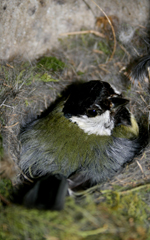Ook bij koolmees komt ouderdom met gebreken

De nakomelingen van oudere koolmeesvrouwtjes zijn veel minder succesvol dan die van jongere moeders. Vooral in latere fases van het opvoeden gaat het mis, concludeert evolutionair biologe Sandra Bouwhuis. Voor de koolmeesvrouw blijkt het zaak om direct in de eerste levensjaren te investeren in het nageslacht. Bouwhuis promoveert op 18 maart 2011 aan de Rijksuniversiteit Groningen op haar onderzoek.
Bouwhuis onderzocht veroudering bij vrouwelijke koolmezen (Parus major) in Wytham Woods (Oxfordshire, UK) en op Vlieland. Ze deed dit aan de hand van onder meer het aantal eieren en nakomelingen en het reproductieve succes van deze nakomelingen.
Oude moeders
Hoewel koolmezen zo’n negen jaar oud kunnen worden, blijkt het broedsucces vanaf het tweede levensjaar al flink af te nemen. Toch beproeven de oude mezen jaarlijks weer hun broedkansen, zegt Bouwhuis: ‘Ze gaan door tot het bittere eind.’
Opvallend is dat aan het begin van de broedperiode nog weinig verschil is tussen de nesten van oude en jonge vrouwtjes. Vooral vlak na het uitvliegen van de jongen vindt er massale sterfte plaats, ontdekte Bouwhuis. ‘Juist in de eerste weken na het uitvliegen moeten de ouders hun jongen nog begeleiden. Die begeleiding laat bij de oude moeders wellicht te wensen over; de jongen vallen bijvoorbeeld ten prooi aan sperwers. Of misschien hebben de oudjes minder gunstige plekken in het bos weten te bemachtigen.’
Wegwerplichaam
Bouwhuis toonde verder aan dat het voor de mezen gunstig is om al in de eerste twee levensjaren zo veel mogelijk te investeren in nageslacht. Zulke hardwerkende mezen verouderen wel veel sneller dan mezen die wat trager op gang komen, maar ondanks dat vroege veroudering zijn prijs heeft, krijgen de vroege broedsters in hun leven uiteindelijk de meeste nakomelingen. ‘De kosten wegen dus op tegen de baten’, zegt Bouwhuis. ‘Het is de theorie van het “wegwerplichaam”: investeren in nakomelingen in plaats van in lichaamsonderhoud. Maar waarom niet alle koolmezen deze tactiek volgen is niet duidelijk.’
Ouderdomskenmerken
Hoewel de aftakeling van de mezen meetbaar is in hun broedsucces, zijn de oudjes er op het oog moeilijk uit te pikken zegt Bouwhuis: ‘Ze hebben in ieder geval geen overduidelijke ouderdomskenmerken zoals rimpels of grijze veren. Er wordt momenteel wel onderzocht of de gele borstveren veranderen naarmate de mezen ouder worden. Het zou namelijk kunnen zijn dat de bejaarde mezen verouderingstekenen vertonen die voor ons helemaal niet opvallen, terwijl ze voor de koolmezen zelf overduidelijk zijn.’
Koolmeesmannen
Hoe het precies zit met oude koolmeesmannen weet Bouwhuis nog niet. ‘We hebben ons in dit onderzoek gericht op de vrouwtjes: mannetjes zijn moeilijker te vangen tijdens het broedseizoen.’ Bovendien gaan de heren koolmezen nog wel eens vreemd vertelt Bouwhuis: ‘Mannetjes kunnen jongen hebben bij hun vaste partner, maar ook bij buitenechtelijke partners. Dat maakt het erg lastig om het aantal nakomelingen te bepalen.’
Curriculum Vitae
Sandra Bouwhuis (Kampen, 1980) studeerde evolutionaire biologie aan de Rijksuniversiteit Groningen (RUG). Ze voerde haar promotieonderzoek uit bij de onderzoeksgroep Behavioural Biology van de RUG en The Edward Grey Institute van de universiteit van Oxford (UK). Het onderzoek werd medegefinancierd door beurzen van de NWO en het Schure-Beijerinck-Popping fonds. Bouwhuis promoveert tot doctor in de wiskunde en natuurwetenschappen bij prof.dr. S. Verhulst, prof.dr. B.C. Sheldon, prof.dr. M.E. Visser en prof. dr. A.G.G. Groothuis. De titel van haar proefschrift luidt: Great tits growing old – patterns and processes of ageing in a wild bird population.
Meer informatie
Sandra Bouwhuis, tel: 0044 1865 281 207, e-mail: sandra.bouwhuis zoo.ox.ac.uk
Meer nieuws
-
11 december 2025
Stormachtige planeten en een onverwachtse atmosfeer
-
09 december 2025
Faculty of Impact Grant voor nieuwe behandeling hersenkanker
